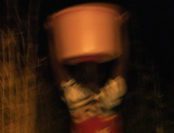[dropcap style=”font-size:100px; color:#992211;”]F[/dropcap]inding patient zero in epidemics is scant consolation for those unlucky enough to have contracted the disease.
Nevertheless, knowledge is power, and one more step towards controlling its spread. Happy New Year, and steer clear of flying mammals.
The outbreak of the Ebola virus disease occurring in West Africa may have originated from contact between humans and virus-infected bats, suggests a study led by researchers from the Robert Koch-Institute in Berlin, Germany. The report, published in EMBO Molecular Medicine, identifies insectivorous free-tailed bats as plausible reservoirs and expands the range of possible Ebola virus sources to this type of bats. The results also reveal that larger wildlife are not the source of infection.
Ebola virus disease epidemics are of zoonotic origin, transmitted to human populations either through contact with larger wildlife or by direct contact with bats. “We monitored the large mammal populations close to the index village Meliandou in south-eastern Guinea and found no evidence for a concurrent outbreak,” says Fabian H. Leendertz of the Robert Koch Institute, who led the study. The second infection route appears more plausible as direct contact with bats is usual in the affected region.
south-eastern Guinea and found no evidence for a concurrent outbreak,” says Fabian H. Leendertz of the Robert Koch Institute, who led the study. The second infection route appears more plausible as direct contact with bats is usual in the affected region.
Fruit bats are the commonly suspected Ebola virus reservoir as previous outbreaks in Africa show. Interviews with Meliandou locals revealed that exposure to fruit bats through hunting and consumption of meat in this area is common. Yet fruit bats seem an unlikely source of infection, as a food-borne transmission would have affected adults before or concurrently with the two-year-old boy – the index case. This suggests a source of infection unrelated to food.
Another opportunity for infection was a large colony of free-tailed insectivorous bats housed in a hollow tree nearby the home of the index case. Villagers reported that children often used to play in and around the tree. This may have resulted in a massive exposure to bats.
The multidisciplinary team of researchers led a four-week field mission in Guinea in April 2014 to examine human exposure to bats, to survey local wildlife and to capture and sample bats in Meliandou and in neighbouring forests. The index village is not located in the forest but rather in an area heavily modified by humans representing “modern” African settings.
The virus that spread from Meliandou into other areas of Guinea and Sierra Leone, Liberia, Nigeria and Senegal, represents the largest ever-recorded Ebola outbreak killing 7,800 people (as of 17 December 2014).
Source: EMBO
Illustration by Dan Booth not to be reproduced without his express prior permission

Some of the news that we find inspiring, diverting, wrong or so very right.



















